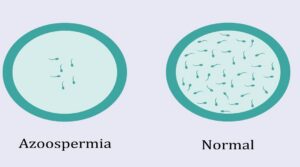Azoospermia: When Guys Can’t Make Babies

Introduction:
Azoospermia is a condition that affects male fertility, leading to the absence of sperm in the ejaculate. This condition poses a significant challenge for couples trying to conceive. Understanding the causes, diagnosis, and available treatments for azoospermia is crucial for those affected by this condition.

What is Azoospermia? Azoospermia is a male reproductive health issue characterized by the absence of sperm in semen. Sperm is essential for fertilizing an egg during natural conception. Azoospermia prevents natural conception as there are no sperm present to fertilize the egg.
Types of Azoospermia
There are two primary types of azoospermia:
- Obstructive Azoospermia: This type occurs due to an obstruction or blockage in the reproductive tract that prevents sperm from reaching the semen. Obstructions can result from congenital issues, infections, or previous surgeries like a vasectomy.
- Non-obstructive Azoospermia: In this type, the testicles produce either no sperm or very low quantities, often due to hormonal imbalances, genetic factors, or testicular damage.
Causes of Azoospermia
Several factors contribute to the development of azoospermia:
- Genetic abnormalities
- Hormonal imbalances
- Infections, such as mumps or sexually transmitted infections (STIs)
- Prior surgeries, including vasectomy or hernia repairs
- Testicular injury
- Radiation therapy or chemotherapy for cancer
- Certain medications
Diagnosis of Azoospermia
Diagnosing azoospermia involves a comprehensive evaluation by a healthcare professional specializing in male fertility. Diagnostic tests may include:
- Semen Analysis: This test examines a sample of semen to detect the presence or absence of sperm.
- Hormone Testing: Evaluating hormone levels can help identify any hormonal imbalances affecting sperm production.
- Genetic Testing: This helps identify any genetic abnormalities contributing to azoospermia.
- Imaging Tests: Ultrasounds or other imaging techniques can reveal obstructions or abnormalities in the reproductive tract.
Treatment Options for Azoospermia
Treatment for azoospermia depends on its underlying cause and type:
- Surgical Interventions: Surgical procedures can correct obstructions in the reproductive tract, enabling the release of sperm into the semen.
- Hormonal Therapy: Hormone treatments can address imbalances and stimulate sperm production in some cases of non-obstructive azoospermia.
- Assisted Reproductive Techniques (ART): ART procedures like in vitro fertilization (IVF) combined with Intracytoplasmic Sperm Injection (ICSI) can help retrieve sperm directly from the testes and facilitate fertilization.
- Donor Sperm: In cases where own sperm retrieval isn’t possible, donor sperm may be an option for conception.
Conclusion
Azoospermia presents a challenge to male fertility, but advancements in medical science offer various treatments to help couples achieve parenthood. Seeking early diagnosis and consulting with a fertility specialist are essential steps toward understanding the condition and exploring available options for conception.
Remember, each case of azoospermia is unique, and tailored treatment plans, along with support from healthcare professionals, can provide hope for couples aspiring to start a family despite this condition.
